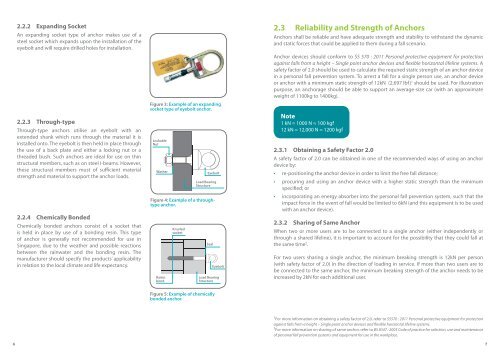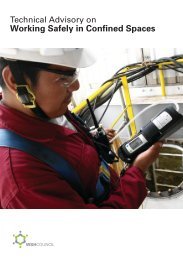HERE - Workplace Safety and Health Council
HERE - Workplace Safety and Health Council
HERE - Workplace Safety and Health Council
Create successful ePaper yourself
Turn your PDF publications into a flip-book with our unique Google optimized e-Paper software.
2.2.2 Exp<strong>and</strong>ing SocketAn exp<strong>and</strong>ing socket type of anchor makes use of asteel socket which exp<strong>and</strong>s upon the installation of theeyebolt <strong>and</strong> will require drilled holes for installation.2.2.3 Through-typeThrough-type anchors utilise an eyebolt with anextended shank which runs through the material it isinstalled onto. The eyebolt is then held in place throughthe use of a back plate <strong>and</strong> either a locking nut or athreaded bush. Such anchors are ideal for use on thinstructural members, such as on steel I-beams. However,these structural members must of sufficient materialstrength <strong>and</strong> material to support the anchor loads.2.2.4 Chemically BondedChemically bonded anchors consist of a socket thatis held in place by use of a bonding resin. This typeof anchor is generally not recommended for use inSingapore, due to the weather <strong>and</strong> possible reactionsbetween the rainwater <strong>and</strong> the bonding resin. Themanufacturer should specify the products’ applicabilityin relation to the local climate <strong>and</strong> life expectancy.Figure 3: Example of an exp<strong>and</strong>ingsocket type of eyebolt anchor.LockableNutWasherFigure 4: Example of a throughtypeanchor.RaisinbondKnurledsocketEyeboltLoad BearingStructureSealEyeboltLoad BearingStructure2.3 Reliability <strong>and</strong> Strength of AnchorsAnchors shall be reliable <strong>and</strong> have adequate strength <strong>and</strong> stability to withst<strong>and</strong> the dynamic<strong>and</strong> static forces that could be applied to them during a fall scenario.Anchor devices should conform to SS 570 : 2011 Personal protective equipment for protectionagainst falls from a height – Single point anchor devices <strong>and</strong> flexible horizontal lifeline systems. Asafety factor of 2.0 should be used to calculate the required static strength of an anchor devicein a personal fall prevention system. To arrest a fall for a single person use, an anchor deviceor anchor with a minimum static strength of 12kN (2,697 lbf) 1 should be used. For illustrationpurpose, an anchorage should be able to support an average-size car (with an approximateweight of 1100kg to 1400kg).Note1 kN = 1000 N ≈ 100 kgf12 kN = 12,000 N ≈ 1200 kgf2.3.1 Obtaining a <strong>Safety</strong> Factor 2.0A safety factor of 2.0 can be obtained in one of the recommended ways of using an anchordevice by:• re-positioning the anchor device in order to limit the free fall distance;• procuring <strong>and</strong> using an anchor device with a higher static strength than the minimumspecified; or• incorporating an energy absorber into the personal fall prevention system, such that theimpact force in the event of fall would be limited to 6kN (<strong>and</strong> this equipment is to be usedwith an anchor device).2.3.2 Sharing of Same AnchorWhen two or more users are to be connected to a single anchor (either independently orthrough a shared lifeline), it is important to account for the possibility that they could fall atthe same time 2 .For two users sharing a single anchor, the minimum breaking strength is 12kN per person(with safety factor of 2.0) in the direction of loading in service. If more than two users are tobe connected to the same anchor, the minimum breaking strength of the anchor needs to beincreased by 2kN for each additional user.Figure 5: Example of chemicallybonded anchor.1 For more information on obtaining a safety factor of 2.0, refer to SS570 : 2011 Personal protective equipment for protectionagainst falls from a height – Single point anchor devices <strong>and</strong> flexible horizontal lifeline systems.2 For more information on sharing of same anchor, refer to BS 8347 : 2005 Code of practice for selection, use <strong>and</strong> maintenanceof personal fall prevention systems <strong>and</strong> equipment for use in the workplace.6 7
















